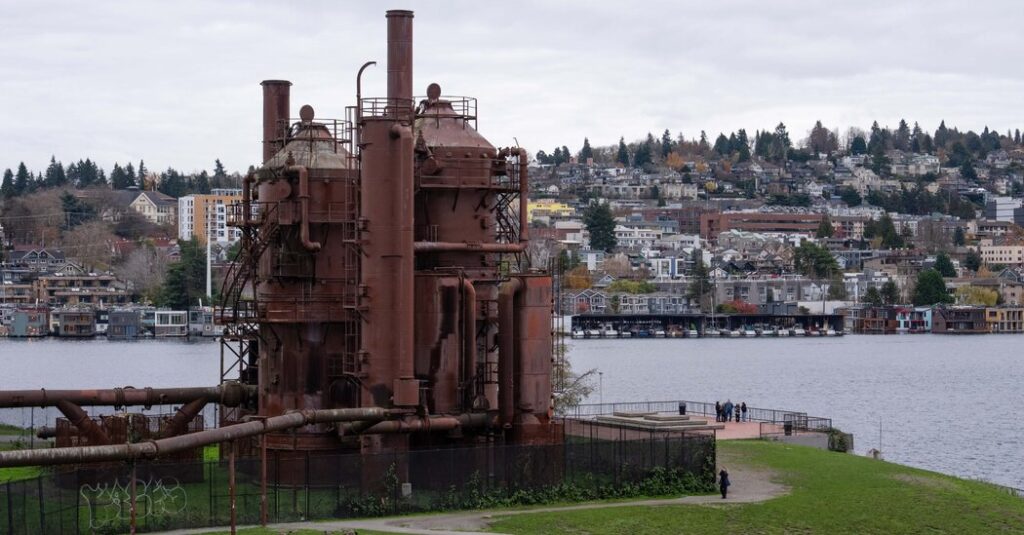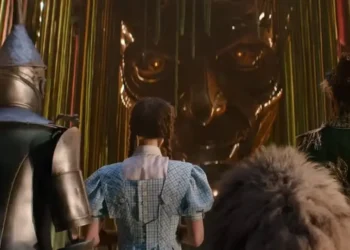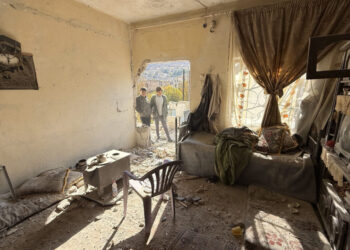On July 10, Mattheis Johnson hopped a bus on a warm summer night to see a pop-up punk rock show at Seattle’s Gas Works Park, a hulking collection of steel towers, tanks and pipes that has become one of the world’s most widely emulated examples of postindustrial landscape design.
His parents felt nervous every time their 15-year-old son asserted his independence, but they also knew he needed adventures. As he left their home in the Ballard neighborhood, his mother called out, “Make good choices.”
Instead, as the concert wound down, Mattheis tried climbing the park towers, shadows of America’s industrial age silhouetted against the skyline of one of its most futuristic cities. He lost his footing, fell 50 feet and died at a nearby hospital — the latest in a long line of severe injuries or deaths involving children and young adults at Gas Works Park.
City leaders have spent decades trying to keep visitors off the park’s structures with man-made and natural barriers, but the climbers have kept coming. More drastic structural changes now under consideration are running headlong into preservationists, architecture buffs and artists who are determined to maintain the park’s structures in their original state.
So the grieving Johnson family, in an end run around the endless debates over architectural intent, are trying a new tack. They want a court to declare the towers a public nuisance.
“We just want the ways that people can access and climb a rickety, rusted-out toxic wasteland to be gone,” Carrie Rees Johnson, Mattheis’s mother, said. “Why is this even a debate?”
In the city’s yearslong effort to safeguard the park and its architectural integrity, nothing has worked. After Mattheis’s death, the third since 2012, the city set aside more than $1.5 million to remove many of the ladders, catwalks and pipes that climbers use. But the volunteer board that oversees landmark preservation in Seattle said no, siding with architects and preservationists.
The fight is reminiscent of the decades-long debate over how to balance suicide prevention at the Golden Gate Bridge, 820 miles south, with maintaining the bridge’s beauty, a fight that ended only last year with the completion of suicide nets that were first commissioned in 1953.
Architects and design buffs are not giving an inch.
“Why would you want to remove something because somebody broke the law and did something destructive?” said Laurie Olin, a Philadelphia-based landscape architect whose résumé includes the redesign of Bryant Park in New York, the gardens around the Getty Center in Los Angeles and Apple’s campus in Cupertino, Calif. “I don’t mean to sound heartless, but what are you going to do about people behaving stupidly?”
From 1906 to 1956, at a plant on the marshy northern shore of Lake Union, the Seattle Gas Light Company heated coal in huge ovens to produce flammable gases used to power lights in homes and businesses. When it closed, the power company left behind rusting towers and a poisonous slurry of ammonia, coal tar, benzene and other toxic byproducts.
Seattle leaders in the 1970s saw a jewel in that mess. They hired the landscape architect Richard Haag, who designed a sheltered pavilion to be built around the old boiler house and pump rooms, a grassy hill formed by removing and capping some of the site’s most contaminated soil and, as a centerpiece, a collection of towers and tanks studded with ladders, valves and catwalks.
Mr. Haag considered the towers to be the park’s heart and soul, Mr. Olin said, a monument to America’s industrial ingenuity.
“That was Rich’s vision: the big raw forms of the towers and then these delicate lines all around them, these funny lines that sort of decorate it like a bit of lace trim,” said Mr. Olin, a student and later a colleague of Mr. Haag’s who helped with some of the early drawings for the park.
To designers and historians, those “funny lines” are elegant architectural quirks. To thrill seekers, they are catwalks, ladders and handholds that have become irresistible.
Today, Gas Works Park’s influence can be seen in other, younger parks built around industrial relics, such as the Landschaftspark Duisburg-Nord in Germany, which was built around an old coal and steel plant, and the Parc des Îles in France, a former coking plant. But preservationists note a key difference: Visitors don’t fall off them.
“People can walk around, people can go on catwalks, and they generally don’t get hurt,” said Patricia Fels, a Seattle architect who worked on the park’s National Register of Historic Places nomination.
They do get hurt in Gas Works Park. A child broke his arm in a fall the year the park opened. Climbing on the towers was never allowed, and it never stopped, whether the goal was graffiti, social media content or just a great view.
The city has experimented with allowing blackberry brambles to grow dense around the structures; installing fences, mesh steel and barbed wire; and increasing the number of police patrols.
But the vegetation became a place for homeless people to hide, and visitors cut holes in the fences or found other ways in.
Like many Seattle-area parents, Ms. Johnson took her young sons to Gas Works Park to hike the hill and marvel at the old machinery. But she said she had never liked the place, home to outdoor yoga classes, company picnics and an annual Fourth of July fireworks show that draws thousands.
“It just always felt sinister,” she said. “Even the things kids are supposed to play on there felt wrong to me.”
Ms. Johnson wept during a recent interview as she described her son: a sweet, somewhat shy boy who loved collecting cards from a game called Magic: the Gathering, playing ultimate Frisbee and making his own hip-hop music. Headed into his junior year of high school, he was interested in dating and learning to drive — “terribly,” his mother said with a teary laugh. He had developed a distinctive, rap-inspired fashion sense with an eye toward a career in design. The day he died, he had stopped home on the way to the concert to charge his phone and because a shirt he had ordered online had just arrived, and he wanted to wear it that night.
“We talked about not climbing out there,” his father, Adam Johnson, said. “The first concert he went to, we talked about not climbing.”
The parents don’t know exactly what happened in their child’s final moments. They have been told their son and a friend were about to head home when some older concertgoers showed them how to sneak through the fence around the towers. A friend’s mother texted to tell them that Mattheis was in an ambulance.
In the days after his death, Seattle parks officials proposed removing the catwalks, the ladders and a pipe that extends over the fence, installing brighter lights and security cameras and painting outlines of the removed structures onto the towers to preserve at least the visual rhythm of Mr. Haag’s design.
But the Seattle Landmarks Preservation Board rejected the proposal after a series of meetings this fall. Members urged deeper study of the park’s structure before any changes. Preservationists and fans of Mr. Haag’s work said they feared that even modest tweaks could damage the towers or lead, eventually, to pressure to dismantle them entirely. They worry the integrity of Mr. Haag’s design is at risk without a more deliberative process.
“The climb hazard, as tragic as that’s been, the conditions that allowed that to happen are really unchanged for decades,” Ian Macleod, a photographer, preservationist and chairman of the landmarks board, said at an Oct. 15 meeting. “I’m not seeing an issue that has changed fairly recently to warrant an emergency proposal.”
Charles Birnbaum, president of the nonprofit Cultural Landscape Foundation, said in an interview, “Sadly, in a tragedy, these situations get politically charged and prone to knee-jerk reactions.”
Mr. Haag, who died in 2018, didn’t include the catwalks and valves — those “delicate lines,” in Mr. Olin’s description — in some of his original renderings. But no one is quite sure whether that’s because he didn’t consider them crucial or just found them a pain to draw.
“We are trying to be true to Rich Haag’s vision,” said David Graves, a strategic adviser with the Seattle Parks and Recreation Department. “It’s also hard to know the full extent of that vision.”
The landmarks board’s decision and inaction by the city prompted the Johnson family to sue on Oct. 30. They opted, at least for now, against a wrongful-death lawsuit and the financial awards such a case can bring. Instead, they want a court order declaring the towers and their appendages a nuisance. That would force changes.
City lawyers responded to the suit last week by asking a judge to throw the case out, even as they acknowledged that over the years “some trespassers” had been injured or killed at the park.
The Johnsons also want a public apology.
“People want us to be ashamed of our son — they want to blame him,” Ms. Johnson said. “But if you put something in a park that looks like it’s meant to be climbed, it’s going to get climbed.”
The post After Teen’s Death, a Seattle Icon Confronts a New Label, Nuisance appeared first on New York Times.




